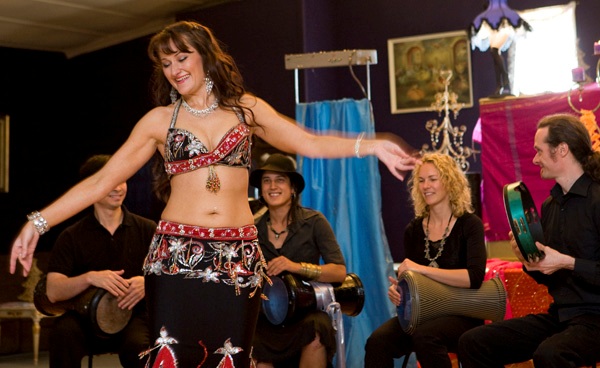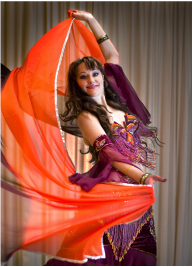
Kaylah and drummer Yeow are excited to be travelling to the World Belly Convention in Korea in June. They are participating in belly dance and folkdance workshops with Tamallyn Dallal, Momo Kadous and drumming workshops with Karim Nagi. Kaylah & Yeow will also be performing their live drum solo at the Closing Dinner Party. More details on the World Bellydancing Convetion here.
Finding the Heartbeat of Middle Eastern Dance Through Drum
Published in the Newsletter for the Organisation of Middle Eastern Dance in Australia, March 2011
I’m Kaylah, a belly dancer from Melbourne. Over the past few years I have been learning the Egyptian tabla and the Moroccan bendir, which is a type of frame drum. I would like to share some of the wonderful insights I have learnt as I progressed through my journey learning drumming and how that has changed me as a dancer.
Understanding of the Music
I have always been told that our aim as the dancer is to interpret and express the music. Middle Eastern music is quite complex, so what a wonderfully challenging job that is!
This is hard to explain, but I’m sure you dancers understand what I mean. I had been listening to Middle Eastern music for so many years, that over time I had got the ‘feel’ of how songs went.
In drumming classes I learnt how song structure works, how the rhythms are repeated, the common patterns and how all this fits together. It explained ‘why’ the songs sound like they do. I learnt the kind of music where each rhythm is played. It is said the heartbeat of Middle Eastern music is the rhythm. Suddenly it all made sense in a logical way and added to my ability to feel the song. I love Middle Eastern music even more now because of this!
It’s so Much Fun!
Learning the technique has been challenging however, with practice, my drumming became more fluent and sounded better. Performing has been great fun, I have met fantastic people and I have even drummed for some of you dancers!
Dance Improvisation - Not so Scary Now
Knowing the rhythms provides me with comfort while I’m dancing as I have an idea of what to expect next in the music. If I know the rhythm I can stick with that or follow the other layers of the music and let them take me where they will, then I can always come back to the rhythm.
Over the years I have been performing as a dancer, I have been blessed to have the opportunity to dance with many live bands. Some of them I have known the musicians, others I was not familiar with their music. Drumming has helped me because even if I didn’t know the song, being familiar with the rhythms gave me confidence to get in the moment of the music, listen with my whole body and let the music come out.
Zilling – No problem!
Before drumming I had rarely used zills in my dance sets for fear of party guests stuffing their ears with serviettes! I have found that the drumming patterns easily translate to zills and they just automatically flow out while I am dancing. I love zilling now and it adds a really lively atmosphere to a dancing show.
Cultural
Learning the history, background and stories behind the rhythms is really interesting. I love the story of the fellahi rhythm used amongst villagers to play their fast folk songs and imagine them dancing on their farms in Egypt!
Communication with and further respect for musicians
I can speak the musician’s language and know what they mean by ‘the song starts off with pure baladi phrases, followed by powerful masmoudi and strong saidi rhythms’. Knowing this in advance, even without hearing the song gives me indication of how the song may feel.
It also gives me the option to ask for something in particular when planning a show with musicians e.g. in addition to the popular songs that the band enjoy playing I sometimes ask for a slow, dramatic chiftetelli to give me a bit of a breather and break up a very fast paced set.
I also see how passionate the musicians are. Just as we dancers train for many years, investing time, money as well as blood sweat and tears into our art, so do musicians. As the show approaches when we are planning and rehearsing, so are the musicians. The effort they put is enormous and we are eternally grateful and appreciative.
I started out on this journey not knowing where it would go, just knowing that I love Middle Eastern music. I now know I have truly found the heartbeat of Middle Eastern music through drumming. From one dancer to another, I say to you, if you have the opportunity to take a drumming class or workshop, go for it. I know you will love it and you can even borrow my drum!!
Kaylah is available to teach workshops for bellydancers on "Dancing to live drumming" as well as "Introductory Drumming for Bellydancers".
Moonee Valley has a long history of migration from European countries located on the Mediterranean Sea, in particular from Italy and Greece. The vibrant contribution that these communities have made to area was celebrated with the first Mediterranean Fiesta held last year.
This year the Mediterranean Fiesta will be bigger and better and will become a showcase for a wider range of Mediterranean cultures such as the Maltese, Croatian, Lebanese, Slovenian, Cypriot and Turkish. The event will celebrate the contributions these communities have made to Moonee Valley through their food, music, art, dance and their traditions.
With cooking demonstrations, live stage performances, workshops and activities for the kids, this is a great day out for the whole family. Belly dance show at 1pm presented by belly dancers Kaylah & Sianna accompanied by their drummers.
The Mediterranean Fiesta is a free event and will take place in a piazza style setting at the Centreway Shopping Centre in East Keilor on Sunday, 27 March from 11am to 4pm.



 RSS Feed
RSS Feed
